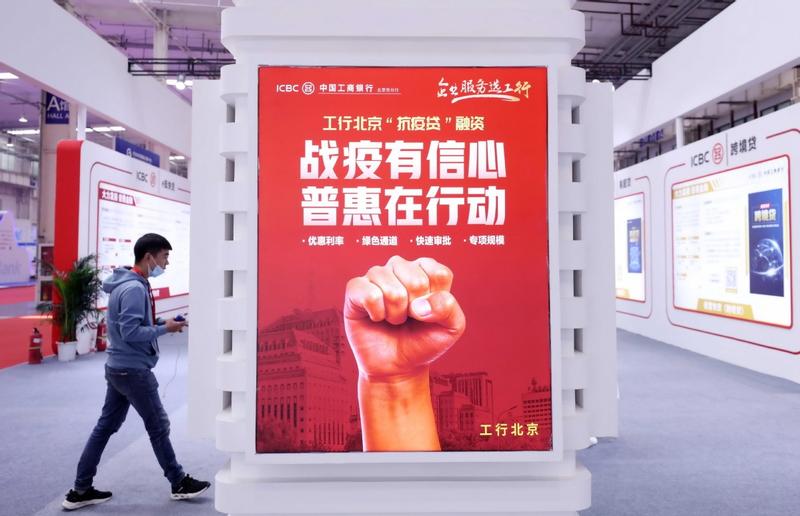 In this undated file photo, a visitor walks past the booth of Industrial and Commercial Bank of China during a financing event in Beijing. (PHOTO BY CHEN XIAOGEN / FOR CHINA DAILY)
In this undated file photo, a visitor walks past the booth of Industrial and Commercial Bank of China during a financing event in Beijing. (PHOTO BY CHEN XIAOGEN / FOR CHINA DAILY)
Monetary authorities have stressed on the need for more policy tools to curb carbon emissions and encouraged commercial banks in China to increase lending for green and low-carbon industries.
Commercial lenders have been asked to promote new products and services in line with the "green finance" standards, improve information disclosure and "adjust the allocation of loans in time", the People's Bank of China (PBOC) said in a statement issued on Thursday after a meeting with 24 major commercial and policy banks.
Although the overall monetary policy stance will remain "neutral" this year-neither too tight nor too loose-the proportion of lending by commercial banks to various industries could be adjusted, focusing more on high-tech, innovative and manufacturing sectors, as well as on projects that support the nation's carbon neutrality goals, experts said.
The central bank also urged financial institutions to consistently optimize the credit structure in key areas as "the recovery of the real economy is not yet solid and weak links still need to be adjusted."
Although the overall monetary policy stance will remain "neutral" this year-neither too tight nor too loose-the proportion of lending by commercial banks to various industries could be adjusted, focusing more on high-tech, innovative and manufacturing sectors, as well as on projects that support the nation's carbon neutrality goals, experts said
PBOC Governor Yi Gang stressed that the overall amount and growth rate of loans should remain stable, with an increase of inclusive loans for small and micro enterprises. The financial sector will continue to surrender part of the profits to the real economy, and the overall financing costs of small and micro firms will decrease, he said.
There are still uncertainties about economic growth recovering this year, although the GDP growth rate will be significantly higher due to the low-base effect. Considering that the growth rate of total social financing should match the growth pace of the nominal GDP, the year-on-year growth rate of loans may be lower than that of last year, said Lou Feipeng, a senior economist at Postal Savings Bank of China.
ALSO READ: Green finance to be key priority
To hedge against economic slowdown amid COVID-19, China's bank loans maintained a high growth rate last year, while domestic and foreign currency loans of financial institutions increased by 12.5 percent on a yearly basis, according to central bank data.
The credit supply structure is expected to see changes this year, said Lou. "Specifically, the growth rate of loans in the property sector may decrease, and fields like scientific and technological innovation, manufacturing sector and green development will see a relatively high growth rate."
Shan Hui, chief China economist at Goldman Sachs, expects a "neutral" monetary policy stance this year, with some structural adjustments to support key areas, such as small and medium-sized enterprises, rural development and green development.
Goldman Sachs revised upward its forecast for China's GDP growth to 8.5 percent from 8 percent and said headline inflation will not rise sharply."We expect the stock growth of total social financing to decelerate from 13.3 percent in 2020 to 11.5 percent in 2021," said Shan.
"Looking at the past few months, growth has been consistent with the PBOC guidance of keeping the total social financing and broad money supply growth in line with the nominal GDP growth. Therefore, from a sequential perspective, we do not expect much further credit growth slowdown."
Bank loans are expected to shift from the property sector to the manufacturing sector, according to the Goldman Sachs economist.
Potential ways for the PBOC to support green finance include window guidance of more bank lending for the green sector, tilting the macro-prudential assessment framework toward green financing, and orienting the relending program toward green financing, said Shan.
Monetary authorities also stressed the need to better assess enterprises' actual credit risks, while improving the international evaluation of performance and incentive measures of commercial lenders. The PBOC also asked banks to increase diversified credit support in provinces facing difficulties and coordinate better regional development.
READ MORE: 5-year blueprint paves way for 2060 carbon neutrality
Multiple factors, such as the balance of assets and liabilities, profits and risk indicators should be included while gauging commercial banks' ability to serve the real economy, the meeting said.



